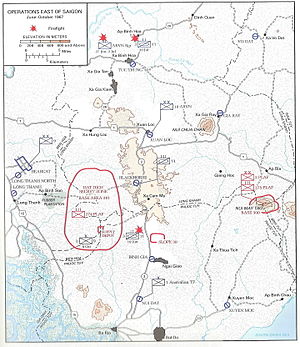Battle of Suoi Chau Pha
| Battle of Suoi Chau Pha | |||||||
|---|---|---|---|---|---|---|---|
| Part of the Vietnam War | |||||||
 Operations east of Saigon, June to October 1967 |
|||||||
|
|||||||
| Belligerents | |||||||
|
|
|
||||||
| Commanders and leaders | |||||||
|
|
|
||||||
| Units involved | |||||||
|
|
|
||||||
| Strength | |||||||
| ~120 men artillery |
~300 men | ||||||
| Casualties and losses | |||||||
| 5 killed 1 died of wounds 20 wounded |
7 bodies recovered 33 more believed killed or wounded in contact 200 further casualties estimated from artillery and airstrikes |
||||||
The Battle of Suoi Chau Pha (6 August 1967) was fought during the Vietnam War between Australian troops and the Viet Cong. The battle took place during Operation Ballarat, an Australian search and destroy operation in the eastern Hat Dich area, north-west of Nui Dat in Phuoc Tuy province. Following a covert insertion the day before which had caught a number of Viet Cong sentries by surprise, A Company, 7th Battalion, Royal Australian Regiment (7 RAR) had patrolled forward unaware of the presence of a large Viet Cong main force unit nearby. Clashing with a reinforced company from the Viet Cong 3rd Battalion, 274th Regiment, a classic encounter battle ensued between two forces of roughly equal size. Fought at close quarters in dense jungle amid a heavy monsoon rain, both sides suffered heavy casualties as neither was able to gain an advantage. Finally, after a battle lasting several hours, the Australian artillery proved decisive and the Viet Cong were forced to withdraw, dragging many of their dead from the battlefield after having suffered crippling losses.
By the second half of 1967 the Viet Cong seemed to have melted away in Phuoc Tuy province, abandoning many of their bunker systems and avoiding the main roads and towns. The Battle of Long Tan and Operation Bribie had weakened the communist forces in the province, while further operations had restricted their movement and logistics. This prompted the commander of the 1st Australian Task Force (1 ATF)—Brigadier Stuart Graham—to speculate that the Viet Cong may have fled to the border, perhaps leaving the province altogether. Graham reasoned that a succession of operations in the south-east of the province and the completion of the barrier minefield at Dat Do meant that no single, sizable threat remained to the populated areas of Phuoc Tuy.
...
Wikipedia
